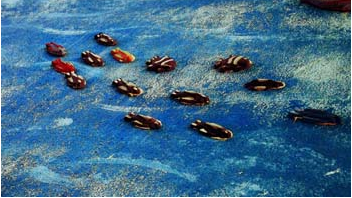 Yanxi Lake: Venue for APEC China 2014
Yanxi Lake: Venue for APEC China 2014
 Top 10 pricey destinations for studying abroad
Top 10 pricey destinations for studying abroad
 Couple chase tornados to create perfect storm photos
Couple chase tornados to create perfect storm photos
 Goddesses at Golden Eagle Festival
Goddesses at Golden Eagle Festival
 J-10 fighters show aerobatic stunts in smog-free sky
J-10 fighters show aerobatic stunts in smog-free sky
 Top 10 charming female soldiers of the PLA
Top 10 charming female soldiers of the PLA
 Charming contestants of Shanghai Int’l Model Contest
Charming contestants of Shanghai Int’l Model Contest
 Most amazing chi-pao beauties
Most amazing chi-pao beauties
 Beauties forever
Beauties forever
 Picturesque autumn scenery of Hongshan Army Horse Ranch
Picturesque autumn scenery of Hongshan Army Horse Ranch
 |
SYDNEY, Oct. 20 -- Scientists have discovered the origins of sex through the study of ancient fish fossils, Nature magazine reported on Monday.
A team led by Australian palaeontologist John Long, from Flinders University in Adelaide, has discovered the time when sexual intercourse developed as a method of reproduction in 430 million-year-old armoured fishes called antiarch placoderms.
Fossils of these creatures show they were the first animals to develop specific male and female genitalia, allowing them to have internal sex. Before fishes developed sex organs both males and females shed their gametes in open water to fertilise.
Long said the sex organ of male antiarch placoderms was two big L-shaped claspers that were inserted into the female's tiny paired genital plates.
"When you look at the shape of these structures they can't possibly do anything in a missionary position," Long told Fairfax Media.
"The only way possible they can do it is sideways, square dance style, with their little arms entangled."
Long's team focused on newly discovered fossils, which suggested the sex act evolved much earlier than first believed.
"This is not just about bony structures on these fish, it's about the evolution of behaviour, of when sex first became fun," Long said.
"Why would something develop these big bony clasper things and place them inside a female unless they enjoyed the act."
 Shocking! Photos of Chinese fighters revealed
Shocking! Photos of Chinese fighters revealed Blue Angels thrill spectators in San Francisco
Blue Angels thrill spectators in San Francisco World's most intimidating nuclear weapons
World's most intimidating nuclear weapons Standard faces for each countries
Standard faces for each countries Who is China's campus beauty queen?
Who is China's campus beauty queen? Netizens fall in love with champion swimmer Ning Zetao
Netizens fall in love with champion swimmer Ning Zetao Vibrant 21-year-old and her own Cheongsam brand
Vibrant 21-year-old and her own Cheongsam brand Fashion style: Faye Wong vs Cecilia Cheung
Fashion style: Faye Wong vs Cecilia Cheung Leading director Wang Quan'an detained for 'buying sex'
Leading director Wang Quan'an detained for 'buying sex' Top 10 handsome football players
Top 10 handsome football players  Top 10 Chinese goddesses
Top 10 Chinese goddesses  Top 20 hottest women in the world in 2014
Top 20 hottest women in the world in 2014 Top 10 fifth generation jet fighters in the world
Top 10 fifth generation jet fighters in the world Top 10 pure beauties in showbiz
Top 10 pure beauties in showbiz  Top 10 world's highest-paid models 2014
Top 10 world's highest-paid models 2014 The most gorgeous Chinese women
The most gorgeous Chinese women Top 10 most handsome faces in Asia
Top 10 most handsome faces in AsiaDay|Week|Month